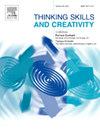How do familial creative climate influence creative scientific problem finding of adolescents: Chain mediation effects of intrinsic motivation for science and conceptual complexity
IF 3.7
2区 教育学
Q1 Social Sciences
引用次数: 0
Abstract
Prior research suggests supportive familial environments can positively impact adolescent creativity. However, it remains unclear whether a familial creative climate, the psychological atmosphere where creativity is encouraged within a family, can enhance adolescents’ ability to identify novel and meaningful scientific problems. Guided by the Ecological Systems Model of Creativity Development, which proposes that individual creativity is shaped by person-environment interactions, this study examines how familial creative climate influences adolescents' creative scientific problem finding through intrinsic motivation for science and conceptual complexity. The network analysis further explored the interactions between these variables. The sample included 610 Chinese secondary students who completed digital surveys. Structural equation modeling revealed that familial creative climate exerted a full indirect positive effect on creative scientific problem finding., mediated either by intrinsic motivation for science or a chain involving both intrinsic motivation and conceptual complexity. Correlation network analysis further highlighted the central roles of encouragement to experience novelty and variety, the proposition of conceptual complexity, and the fluency of creative scientific problem finding in driving these mechanisms. These findings confirm the significance of familial creative climate in nurturing adolescent creative scientific problem finding and provide insights into the complex interplay between familial and personal factors.
求助全文
约1分钟内获得全文
求助全文
来源期刊

Thinking Skills and Creativity
EDUCATION & EDUCATIONAL RESEARCH-
CiteScore
6.40
自引率
16.20%
发文量
172
审稿时长
76 days
期刊介绍:
Thinking Skills and Creativity is a new journal providing a peer-reviewed forum for communication and debate for the community of researchers interested in teaching for thinking and creativity. Papers may represent a variety of theoretical perspectives and methodological approaches and may relate to any age level in a diversity of settings: formal and informal, education and work-based.
 求助内容:
求助内容: 应助结果提醒方式:
应助结果提醒方式:


